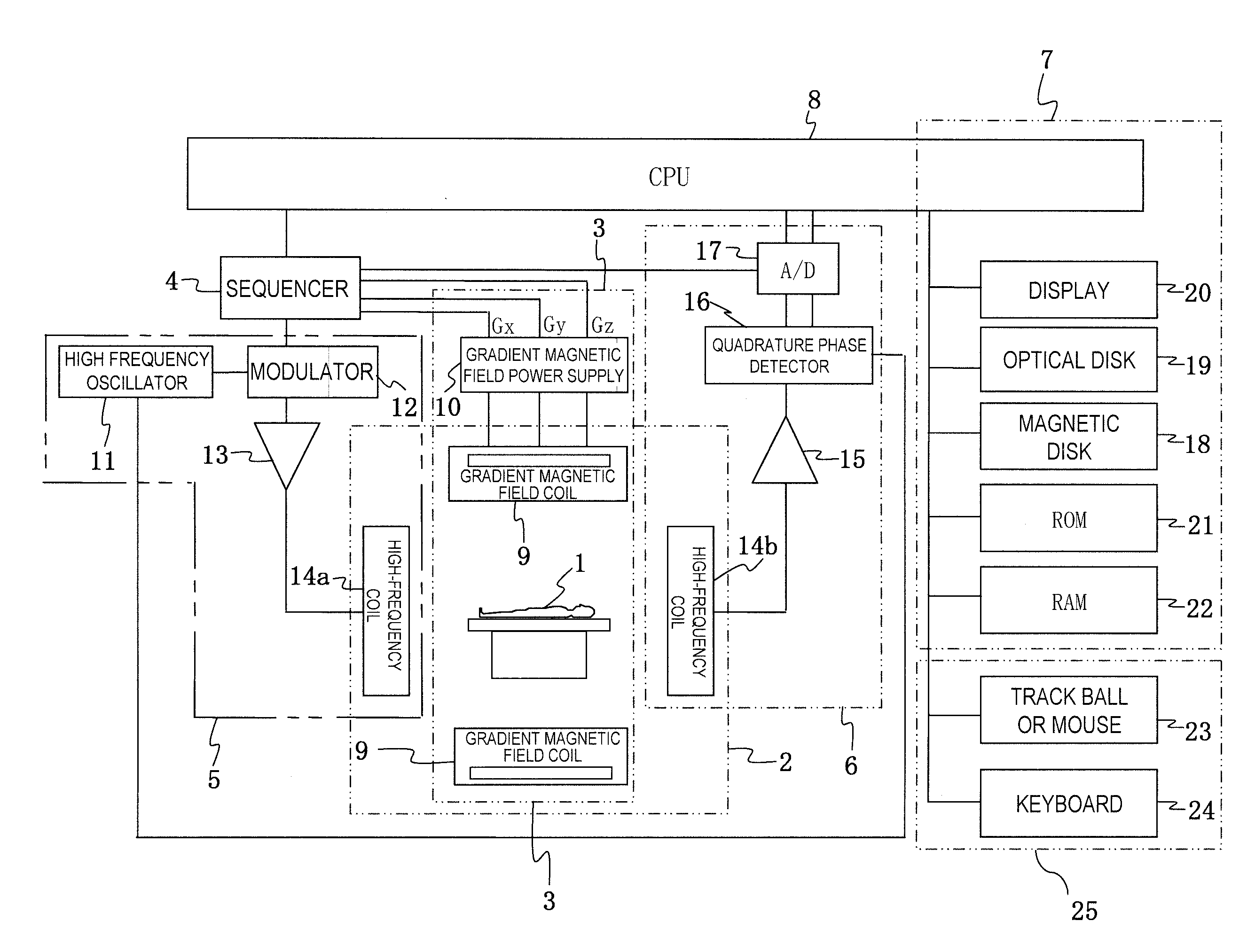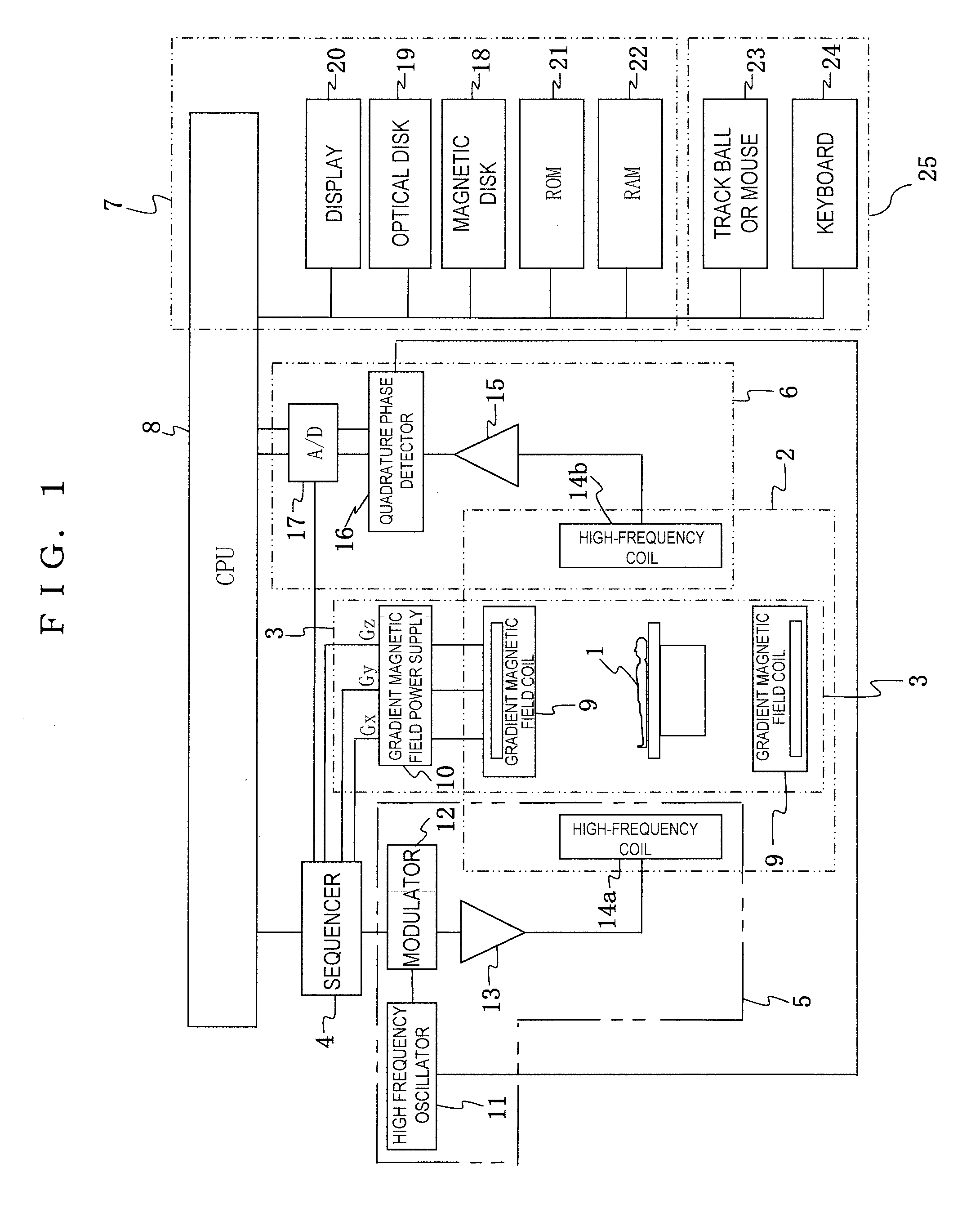Magnetic resonance imaging apparatus, and breath-holding imaging method
- Summary
- Abstract
- Description
- Claims
- Application Information
AI Technical Summary
Benefits of technology
Problems solved by technology
Method used
Image
Examples
first embodiment
[0043]Next, a first embodiment of the MRI apparatus and the breath-holding imaging method of the present invention will be described. In the present embodiment, corresponding to imaging conditions of breath-holding measurement which are input and set according to the subject, one scan is divided into one or more breath-holding measurements and free-breathing measurements and a region of the k space measured in the breath-holding measurement is controlled. Alternatively, one scan may be divided into only two or more breath-holding measurements with no free-breathing measurement. Preferably, low-frequency data of the k space is measured during the breath-holding measurement period. As imaging conditions for the breath-holding measurement, the number of times of breath holding and a breath-holding time are included.
[0044]Hereinafter, the present embodiment will be described on the basis of FIGS. 2 to 4. FIG. 2 is a time chart showing the concept of the present embodiment, FIG. 3 is a f...
second embodiment
[0090]A second embodiment of the MRI apparatus and the breath-holding imaging method of the present invention will be described. In the first embodiment described above, TBH was set as a breath-holding time per time [second]. In the present embodiment, however, a total breath-holding time is included as imaging conditions for breath-holding measurement and TBH is set as a total time of “NBH” breath holding. That is, an upper limit of the burden in breath holding of the subject is set as the total breath-holding time TBH. Hereinafter, only a different point from the first embodiment will be described, and an explanation regarding the same point will be omitted.
[0091]FIG. 8 is a time chart showing the concept of the present embodiment, and FIG. 9 is a flow chart showing an example of the process flow of the present embodiment.
[0092]As shown in FIG. 8, in the present embodiment, first, a single scan with a total measurement time of TTotal [second] (801) is divided into a breath-holding...
third embodiment
[0103]A third embodiment of the MRI apparatus and the breath-holding imaging method of the present invention will be described. In each of the embodiments described above, there was no particular limitation on a pulse sequence. In the present embodiment, however, k space data is measured slice by slice when the present invention is applied to imaging using SSFP (Steady State Free Precession) sequence. Moreover, in breath-holding measurement, the low-frequency data of the k space corresponding to each slice is measured.
[0104]The SSFP sequence is a sequence in which an RF pulse is irradiated at short intervals (TR) and an echo signal is repeatedly measured from transverse magnetization shifted to the steady state (for example, JP-A-2004-329268. An example of filling the echo data into the k space in the SSFP sequence is shown in FIG. 10a. In the SSFP sequence, in many cases, the echo data is measured to fill the k space slice by slice so that the steady state of transverse magnetizati...
PUM
 Login to View More
Login to View More Abstract
Description
Claims
Application Information
 Login to View More
Login to View More - R&D
- Intellectual Property
- Life Sciences
- Materials
- Tech Scout
- Unparalleled Data Quality
- Higher Quality Content
- 60% Fewer Hallucinations
Browse by: Latest US Patents, China's latest patents, Technical Efficacy Thesaurus, Application Domain, Technology Topic, Popular Technical Reports.
© 2025 PatSnap. All rights reserved.Legal|Privacy policy|Modern Slavery Act Transparency Statement|Sitemap|About US| Contact US: help@patsnap.com



